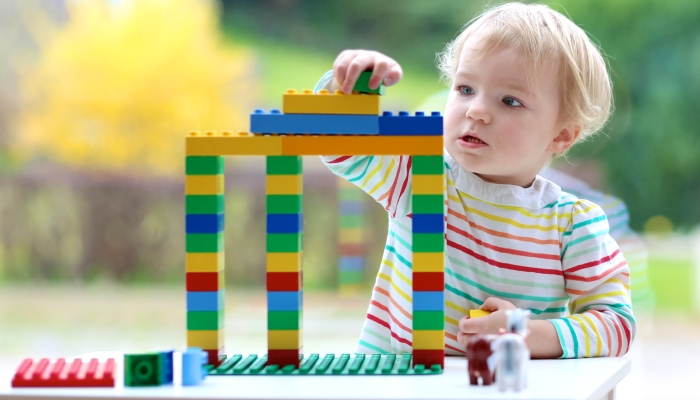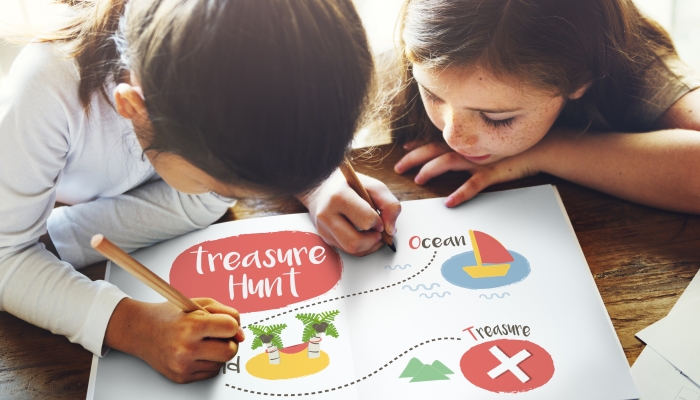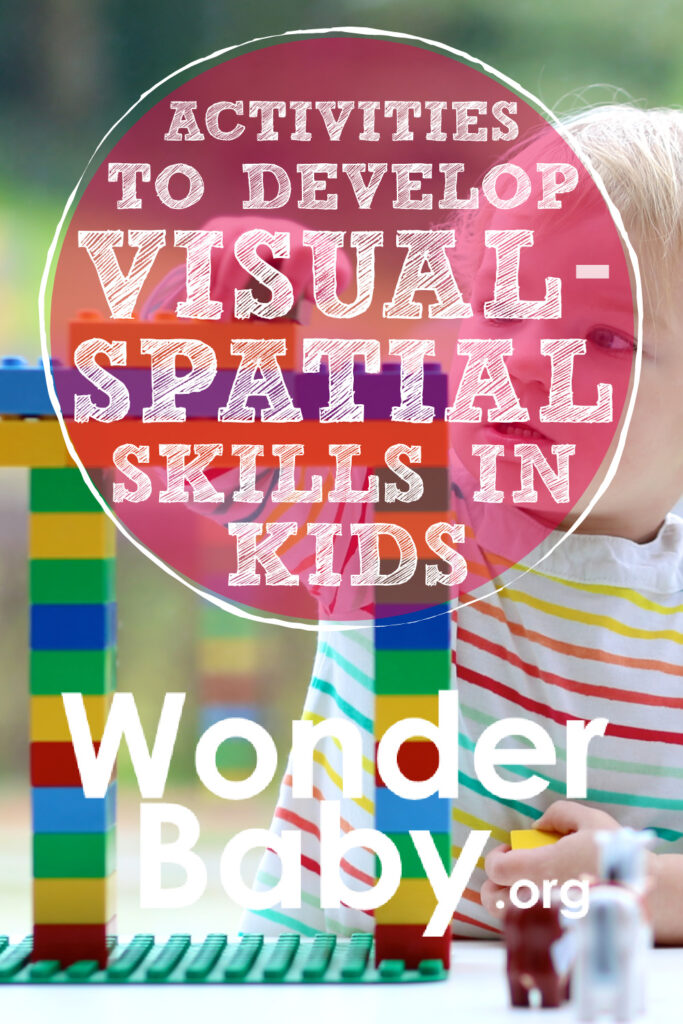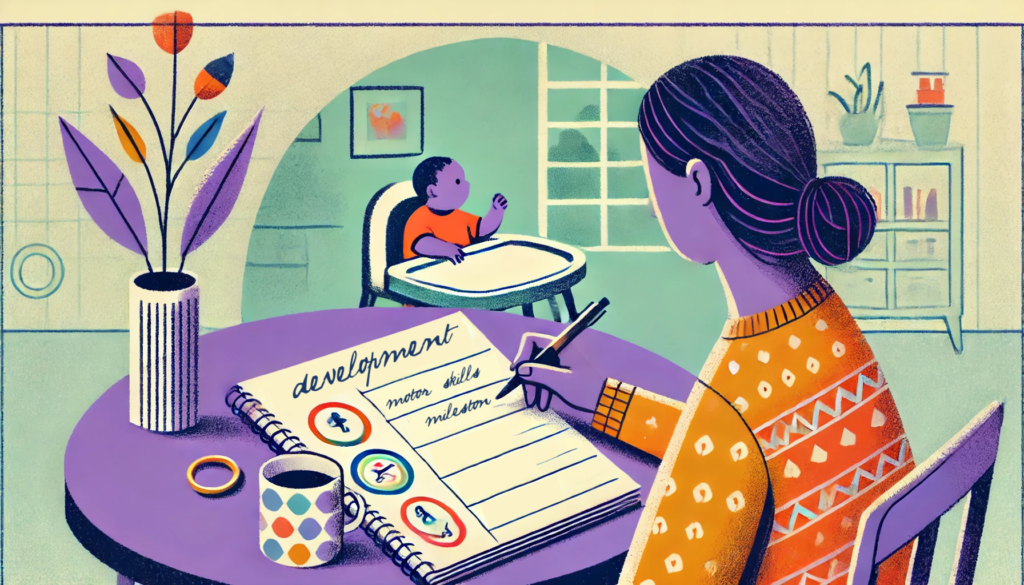10 Activities to Develop Visual-Spatial Skills in Kids

- Visual-spatial skills refer to the ability to understand and interpret visual information. This includes understanding spatial relationships between objects.
- Strong visual-spatial processing skills are linked to performance in math and other subjects.
- We need visual processing skills for everyday tasks, including navigating new environments.
- Visual processing skills are malleable and can be improved. Addressing visual processing difficulties can positively impact your child’s development.
- Playing with blocks, solving puzzles, and using maps are some ways to help children improve their visual-spatial ability.
You might not have heard of visual-spatial skills before, but they play a vital part in your daily life.
Have you ever assembled furniture, packed a suitcase, parked a car, completed a puzzle, or read a map?
These tasks all require the ability to interpret visual information and understand the spatial relationships between objects. Strong visual-spatial processing skills can make these tasks easier and more efficient.
Strong visual-spatial skills in kids are not only helpful for things like solving a jigsaw puzzle or building a block tower. They can also help them achieve academically in school, including in mathematics, science, and literacy.
Being exposed to different visuals, playing, and exploring are all important for children to develop these skills. When parents understand how important these skills are and support their child to develop them, it can help them in both school and life.
What Are Visual-Spatial Skills?
Visual-spatial skills refer to the ability to understand and interpret visual information. This includes:
- Shapes and sizes
- Spatial relations and perspective
- Distances, measurements, and coordinates
These skills allow us to do some impressive and important things! Visual-spatial processing skills help children to:
- Manipulate objects in their minds
- Recognize patterns
- Spot relationships between objects
- Understand maps and diagrams
- Navigate new environments
Visual-spatial processing skills begin in infancy. Research by Susan Hespos, Ph.D., and Philippe Rochat, Ph.D. (1997) found that babies as young as 4 months show signs of visual-spatial understanding.
These skills continue to develop through childhood as infants develop an understanding of visual-spatial relations. This includes concepts of “in” and “out,” object rotations, and an understanding of geometric shapes.

How Important Is Visual-Spatial Development for Children?
We use visual-spatial skills all the time as adults—when we’re driving or exploring new places, for example. These skills are important for learning in school too, especially in math, science, and reading.
In fact, as Weipang Yang, Ph.D., et al. note in their meta-analysis: “Spatial skills significantly predict educational and occupational achievements in science, technology, engineering, and mathematics (STEM).” They refer to literature that shows that visual-spatial processing is linked to the following areas:
- Map use
- Numerical skills
- Arithmetic development
- Math reasoning
- Math knowledge
- Early writing skills
- Early reading skills
- Visual-motor skills
- Executive functions
Signs That a Child Struggles With Visual-Spatial Awareness
A child who has difficulty with visual-spatial processing may struggle with certain tasks, such as:
- Solving puzzles
- Recognizing shapes
- Understanding patterns
- Understanding the spatial relationships between objects
Kids who struggle with visual-spatial skills might have a hard time with schoolwork. They may need some extra support with activities that require spatial reasoning.
Nonverbal Learning Disability (NVLD) is thought to affect around 3–4% of the population. Irene Mammarella, Ph.D., defines NVLD as, “a relatively unknown neurodevelopment disorder characterized by visuospatial difficulties, such as problems in learning or encoding through pictures, processing gestures or motor patterns, and orienting in space.”
Currently, NVLD isn’t recognized in international classification systems such as the DSM-5. This means that you may struggle to find support and guidance, and your child’s teachers may not be aware of their difficulties. It’s important to work together with your child and their educators to help overcome any barriers to learning.
How Can You Help Improve Your Kid’s Visual-Spatial Ability?
Several studies have found that spatial skills are malleable. Visual-spatial activities have been shown to significantly improve these skills. Some of the best ways to help your child with their visual-spatial processing include:
- Hands-on tactile exploration of objects
- Using spatial language during play (e.g. “the ball is under the cup”)
- Visual prompts and cues
- Using maps and directional language
- Using gestures (e.g. pointing)
If you want to help your child get better at visual-spatial skills, give them plenty of chances to play with and look at different things. This can help them understand how things are related to each other in space and make it easier for them to imagine things in their minds.

10 Activities to Develop Visual-Spatial Skills in Kids
Kids can develop their visual-spatial skills through play and by doing regular activities. Some specific types of play can be especially helpful. Here are ten of my favorite activities for developing visual-spatial skills:
Building Blocks or Lego®
A key feature of effective visual-spatial activities is the use of hands-on manual exploration of objects. Building blocks are perfect for this!
Encourage your child to get creative and experiment with different designs. Also, look out for language opportunities to support their spatial awareness. It can be helpful to narrate parts of their play, for example, “You’ve put the small block between the two large blocks.”
Puzzles
Puzzles are a fantastic tool for developing visual-spatial processing and reasoning. When your child works on a puzzle, they practice thinking about how the shapes fit together. This can help them get better at mental rotation and spatial reasoning.
There’re many different toddler puzzles available to suit different ages and skills.
Computerized Rotations
Video games and shape rotations on screen have also been shown to improve visual perceptual skills.
Try inserting a shape into a word processor and playing around with the rotation options. If that sounds too technical, you could also try a ready-made game that allows you to rotate and manipulate shapes. I tried out a few and my favorite was the Pattern Shape app from the Math Learning Center.
Tangram Play
A tangram is a type of puzzle from China made using only 7 shapes. Using the shapes, you can create different designs, like animals, objects, and numbers.
You can use a tangram to help your child practice manipulating shapes in a variety of ways. They’re a fun challenge for both adults and children!
Shape Sorters
Shape-sorting toys provide a wonderful opportunity for your child to manipulate objects.
These toys allow your child to play with object rotation and problem-solving. They also develop the ability to match visual input with physical movement to accurately place objects where they belong.
Mapping Skills
Reading a map requires a high level of visual processing skills.
For younger children, you could use toy figures and buildings to create a map for them to understand the concept of spatial location. Older children may enjoy orienteering or using a floor plan of your house to assist them on a treasure hunt.
Using physical maps or Google Maps can also help children to understand scale, distance, and direction.
Drawing, Arts, and Crafts
Drawing and coloring activities can be really helpful for visual-spatial skills.
When drawing, they need to think about things like how big to make each object, where to place it on the page, and how to draw it in relation to other objects.
Crafts can also help your child to develop spatial skills. Origami is an example of an activity that challenges your child to understand geometric principles.
Montessori Materials
Montessori-aligned toys are designed to develop children’s skills, including visual-spatial processing.
Traditional Montessori toys, such as vertical stackers, help to grow children’s spatial abilities.
Visual Stimuli
Exposing your child to a variety of visuals and patterns can help them to understand visual information.
These helpful stimuli can be found all around you—in art, nature, museums, architecture, and picture books.
Pencil Obstacle Course
Add some toy figures or draw obstacles onto a piece of paper for your child to navigate their way around with their pencil.
This is an easy activity to set up which encourages positional language understanding such as “over,” “under,” and “between.”
Pencil mazes and other visual puzzles are also excellent tools for developing visual processing skills.
FAQs
How are visual-spatial skills linked to literacy learning?
The links with math and science may seem more obvious—but visual-spatial skills also help children with literacy. Some reading difficulties are linked to visual-spatial deficits.
Children with strong visual-spatial skills are better able to recognize and remember the shapes of letters and words. Spatial skills will also help them to understand text structures like paragraphs.
What is visual-motor integration?
Visual motor skills are when your child interprets what they see to guide and direct physical action. For example, seeing a zig-zag line on a page and using scissors to cut along the line.
It’s not just related to fine motor activities. Visual-motor skills also help your child to do things like catch a ball, climb a ladder, or ride a bike. This is because they need to process what they see and coordinate their movements accordingly.
If your child is struggling with visual-motor skills coordination, an occupational therapist can help.
Are children who are strong visual-spatial learners more intelligent?
Children with strong visual processing skills may be more likely to excel in certain areas such as mathematics. They’re also more likely to enter a profession that uses these skills, such as architecture or engineering.
While visual-spatial skills can be a useful tool for success in some areas, they’re just one element of overall intelligence.
It’s important to avoid labeling children based on a single ability or type of skill. All children have unique challenges and strengths. It’s up to caregivers to recognize and nurture these differences in a positive and supportive way.

Related Posts

Development, Special Needs
How to Track Milestones for Developmentally Delayed Babies
Parents of developmentally delayed babies can explore practical tools and strategies to track milestones, celebrate progress, and support their child’s unique developmental journey.

Fine and Gross Motor
5 Alternatives to Tummy Time for Babies with Motor Development Challenges
Does your baby struggle with tummy time due to motor development challenges? These alternatives to tummy time will offer the same benefits.

Development
Should Twins Share a Room?
Wondering if your twins should share a room? We’ll explore the pros and cons of room-sharing for twins right here before you make your decision.